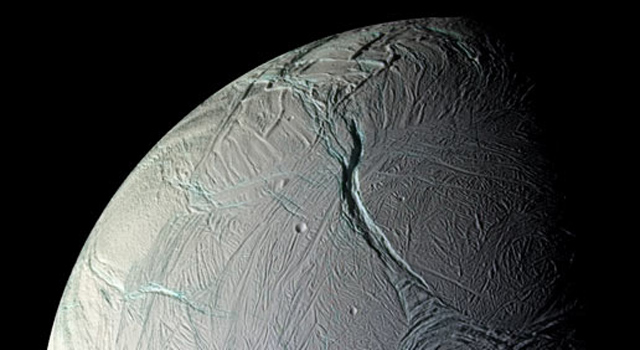shedding light on the evolution of planets and guiding future space exploration.
Dr Dave Stegman, a Centenary Research Fellow in the School of Earth Sciences at the University of Melbourne, led the study and says that part of the intrigue with Enceladus is that it was once presumed to be a lifeless, frozen ice ball until a water vapour plume was seen erupting from its surface in 2006.
"NASA's Cassini spacecraft recently revealed Enceladus as a dynamic place, recording geological features such as geysers emerging from the 'tiger stripes' which are thought to be cracks caused by tectonic activity on the south pole of the moon's surface," says Dr Stegman.
The moon is also one of the brightest objects in our solar system because the ice covering its surface reflects almost 100 percent of the sunlight that strikes it. One of Saturn's 53 moons (so far identified) Enceladus reflects so much of the sun's energy that its surface temperature is about -201° C (-330° F).

On Oct. 5, 2008, just after coming within 25 kilometers (15.6 miles) of the surface of Enceladus, NASA’s Cassini captured this stunning mosaic as the spacecraft sped away from this geologically active moon of Saturn. Image credit: NASA/JPL/Space Science Institute
Grappling with how an inaccessible small moon with a completely frozen interior was capable of displaying geological activity, Dr Stegman and colleagues used computer simulations to virtually explore it.
Ammonia, usually found on Earth as an odorous gas used to make fertilizers, has been indirectly observed to be present in Enceladus and formed the basis of the study which is the first to reveal the origins of the subsurface ocean.
The model reveals that Enceladus initially had a frozen shell composed of a mixture of ammonia and water ice surrounding a rocky core. Over time, as Enceladus interacted with other moons, a small amount of heat was generated above the silicate core which made the ice shell separate into chemically distinct layers. An ammonia-enriched liquid layer formed on top the core while a thin layer of pure water ice formed above that. The work will be published in the August issue of the planetary science journal, Icarus.
"We found that if a layer of pure water ice formed near the core, it would have enough buoyancy to rise upwards, and such a redistribution of mass can generate large tectonic stresses at the surface," says Dr Stegman. "However, the pure water ice rising up is also slightly warmer which causes the separation to occur again, this time forming an ammonia-enriched ocean just under the surface. The presence of ammonia, which acts as an anti-freeze, then helps keep the ocean in its liquid state."
"These simulations are an important step in understanding how planets evolve and provide questions to focus future space exploration and observations. It will hopefully progress our understanding of how and why planets and moons are different to each other."





Comments